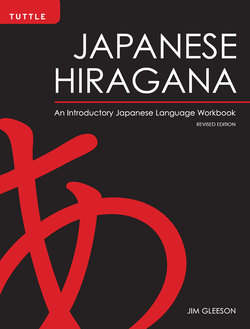Читать книгу Japanese Hiragana - Jim Gleeson - Страница 4
На сайте Литреса книга снята с продажи.
ОглавлениеPreface
It is widely accepted that students of Japanese progress more quickly if they learn the written component of the language at an early stage of their studies. Unfortunately, many students are daunted by the task of learning a large number of seemingly complex characters.
The complexity of Japanese characters, however, is something of an illusion, for many of the characters are merely combinations of comparatively few elements. This fact becomes apparent as one progresses through the two forty-eight character syllabaries, known collectively as kana, and the two thousand or so kanji characters that are used in written Japanese today.
Anybody who is able to master English, with its irregular spellings and idiosyncratic pronunciations, is more than equipped to master written Japanese.
The hiragana and katakana syllabaries are purely phonetic characters, which function much like the letters of the English alphabet. In this respect, kana are quite different from kanji characters, which are based on Chinease ideographs. The basic function of hiragana is to supplement the kanji.
Generally, kanji are used to represent the ideas in a sentence while hiragana is used to represent the relationships between the ideas. For example, whereas the concept of 'go' would be written in kanji, hiragana would be suffixed to the kanji to indicate "want to go," "went," "will not go," and so forth. Hiragana is also used for particles such as "to," "in," "by" and "at."
Each of the hiragana and katakana syllabaries represents all of the sounds in spoken Japanese. Unlike kanji, which can take on a variety of pronunciations according to their context, the pronunciation of the kana characters is quite regular. Although it is possible to write Japanese using only hiragana, a native Japanese speaker would find it somewhat difficult to understand. Kanji are used for clarity, eloquence, and immediacy of meaning. It is customary for the student to write using only hiragana at first, then to substitute kanji into their writing as each character is learned.
Japanese schoolchildren learn their characters by writing them out, and this is generally acknowledged as the fastest way to master them.
This book has been prepared so that students at the introductory level of Japanese can become acquainted with the written component of the language in the quickest possible way. The overriding priority has been given to active student involvement, with a variety of practice sentences and expressions provided to reinforce the characters learned at each stage of progress. The book also features grayed-out, trace-over characters to enable the student to gain the correct feel and balance of each character.
To avoid repetition, this book uses the dictionary form of verbs rather than the ~masu form. In the majority of situations, however, it is customary to write using the ~masu form.
This book uses the Hepburn system of romanization. It is important to remember, however, that Japanese is a separate language with an independent set of sounds to English, and hence, any attempt to romanize it can only be an approximation.
